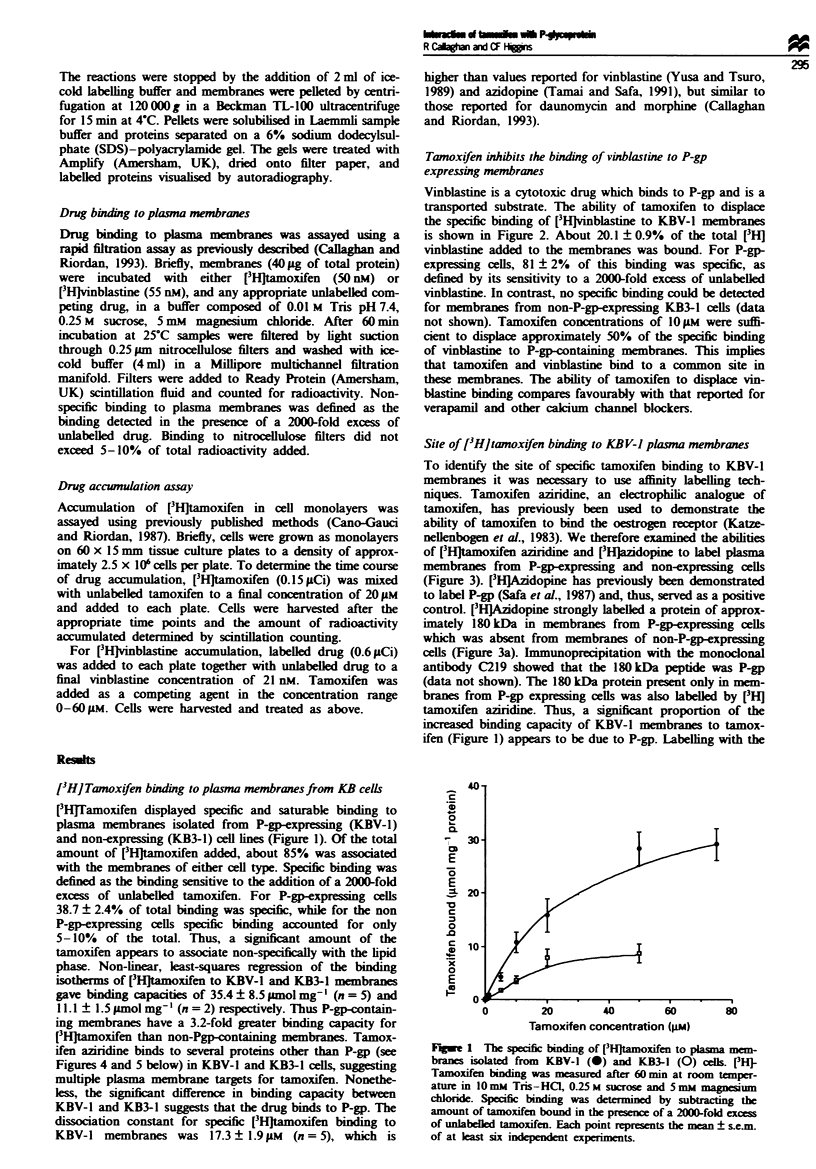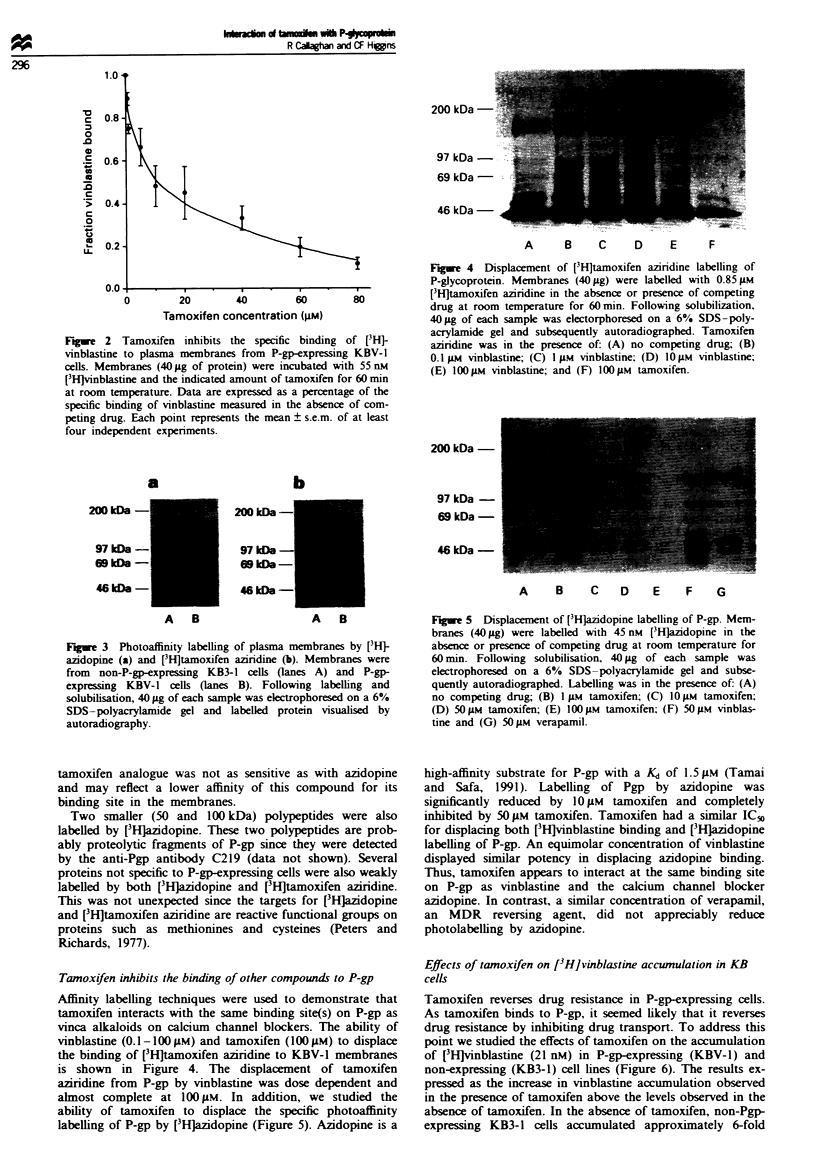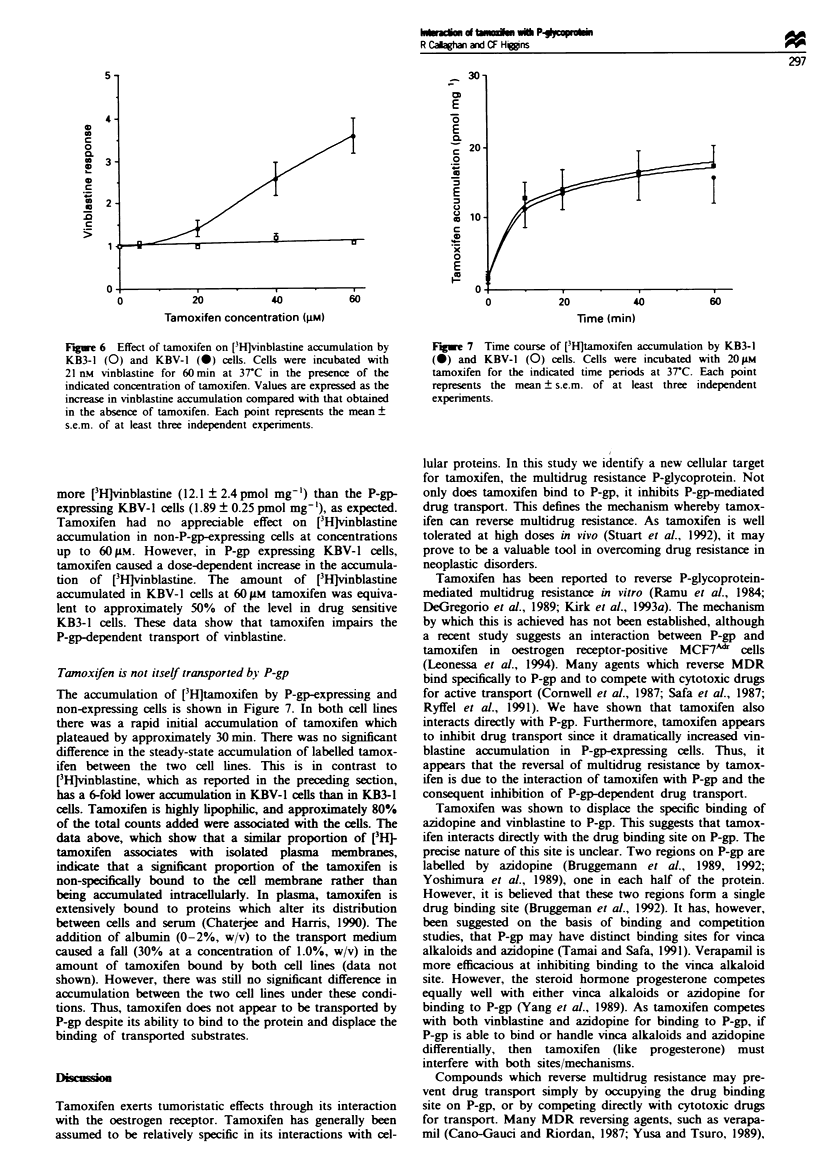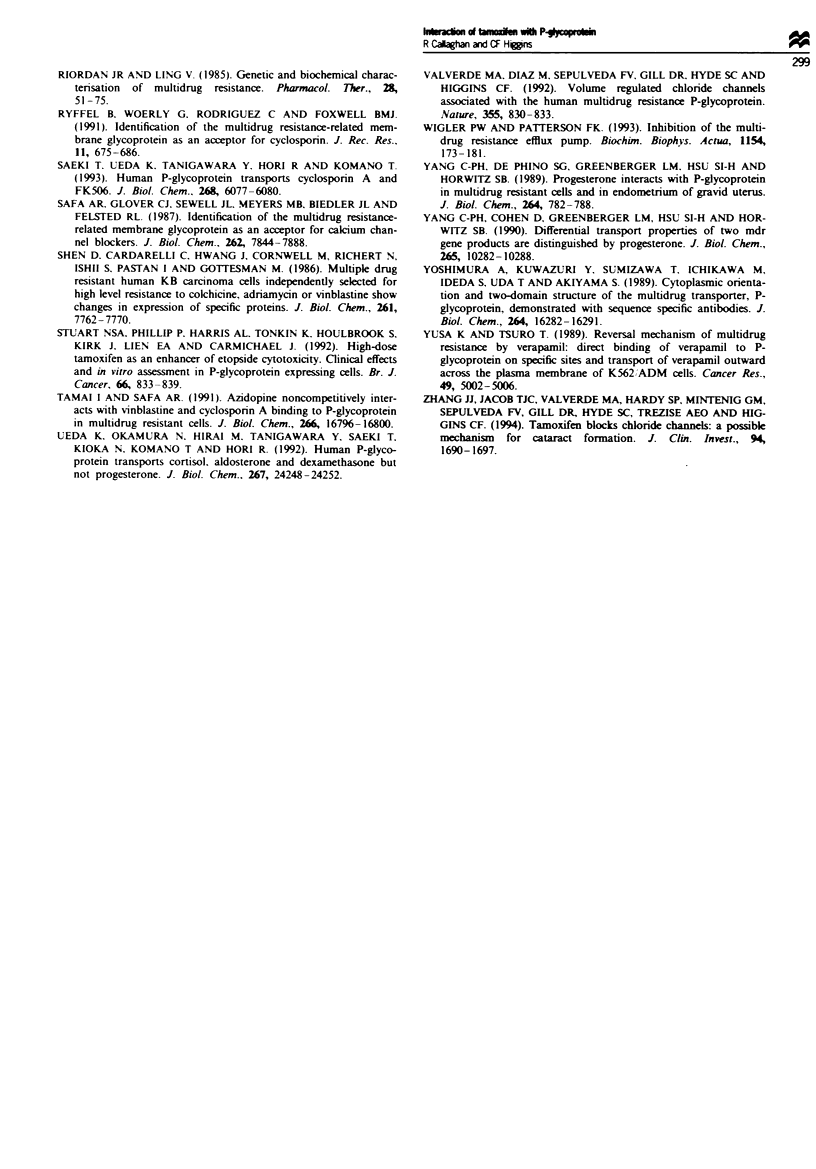Abstract
Tamoxifen is an anti-oestrogen which is currently being assessed as a prophylactic for women at high risk of breast cancer. Taxoxifen has also been shown to reverse multidrug resistance in P-glycoprotein (P-gp)-expressing cells, although the mechanism of action is unknown. In this study we demonstrate that tamoxifen interacts directly with P-gp. Plasma membranes from P-gp-expressing cells bound [3H]tamoxifen in a specific and saturable fashion. A 180 kDa membrane protein in these membranes, labelled by the affinity analogue tamoxifen aziridine and azidopine, was shown to be P-gp. Tamoxifen reduced the binding of vinblastine and azidopine to P-gp, and tamoxifen increased [3H]vinblastine accumulation in P-gp-expressing cells to levels approaching those in non-P-gp-expressing cells. However, the cellular accumulation of [3H]tamoxifen itself was not influenced by the presence of P-gp. Thus, tamoxifen appears to reverse multidrug resistance by binding to P-gp and inhibiting the transport of cytotoxic drugs, but does not itself appear to be transported by the protein.
Full text
PDF





Images in this article
Selected References
These references are in PubMed. This may not be the complete list of references from this article.
- Berthois Y., Katzenellenbogen J. A., Katzenellenbogen B. S. Phenol red in tissue culture media is a weak estrogen: implications concerning the study of estrogen-responsive cells in culture. Proc Natl Acad Sci U S A. 1986 Apr;83(8):2496–2500. doi: 10.1073/pnas.83.8.2496. [DOI] [PMC free article] [PubMed] [Google Scholar]
- Bruggemann E. P., Currier S. J., Gottesman M. M., Pastan I. Characterization of the azidopine and vinblastine binding site of P-glycoprotein. J Biol Chem. 1992 Oct 15;267(29):21020–21026. [PubMed] [Google Scholar]
- Bruggemann E. P., Germann U. A., Gottesman M. M., Pastan I. Two different regions of P-glycoprotein [corrected] are photoaffinity-labeled by azidopine. J Biol Chem. 1989 Sep 15;264(26):15483–15488. [PubMed] [Google Scholar]
- Callaghan R., Riordan J. R. Synthetic and natural opiates interact with P-glycoprotein in multidrug-resistant cells. J Biol Chem. 1993 Jul 25;268(21):16059–16064. [PubMed] [Google Scholar]
- Cano-Gauci D. F., Riordan J. R. Action of calcium antagonists on multidrug resistant cells. Specific cytotoxicity independent of increased cancer drug accumulation. Biochem Pharmacol. 1987 Jul 1;36(13):2115–2123. doi: 10.1016/0006-2952(87)90139-0. [DOI] [PubMed] [Google Scholar]
- Chatterjee M., Harris A. L. Reversal of acquired resistance to adriamycin in CHO cells by tamoxifen and 4-hydroxy tamoxifen: role of drug interaction with alpha 1 acid glycoprotein. Br J Cancer. 1990 Nov;62(5):712–717. doi: 10.1038/bjc.1990.365. [DOI] [PMC free article] [PubMed] [Google Scholar]
- Cornwell M. M., Gottesman M. M., Pastan I. H. Increased vinblastine binding to membrane vesicles from multidrug-resistant KB cells. J Biol Chem. 1986 Jun 15;261(17):7921–7928. [PubMed] [Google Scholar]
- Cornwell M. M., Pastan I., Gottesman M. M. Certain calcium channel blockers bind specifically to multidrug-resistant human KB carcinoma membrane vesicles and inhibit drug binding to P-glycoprotein. J Biol Chem. 1987 Feb 15;262(5):2166–2170. [PubMed] [Google Scholar]
- DeGregorio M. W., Ford J. M., Benz C. C., Wiebe V. J. Toremifene: pharmacologic and pharmacokinetic basis of reversing multidrug resistance. J Clin Oncol. 1989 Sep;7(9):1359–1364. doi: 10.1200/JCO.1989.7.9.1359. [DOI] [PubMed] [Google Scholar]
- Gill D. R., Hyde S. C., Higgins C. F., Valverde M. A., Mintenig G. M., Sepúlveda F. V. Separation of drug transport and chloride channel functions of the human multidrug resistance P-glycoprotein. Cell. 1992 Oct 2;71(1):23–32. doi: 10.1016/0092-8674(92)90263-c. [DOI] [PubMed] [Google Scholar]
- Gottesman M. M., Pastan I. Biochemistry of multidrug resistance mediated by the multidrug transporter. Annu Rev Biochem. 1993;62:385–427. doi: 10.1146/annurev.bi.62.070193.002125. [DOI] [PubMed] [Google Scholar]
- Horio M., Gottesman M. M., Pastan I. ATP-dependent transport of vinblastine in vesicles from human multidrug-resistant cells. Proc Natl Acad Sci U S A. 1988 May;85(10):3580–3584. doi: 10.1073/pnas.85.10.3580. [DOI] [PMC free article] [PubMed] [Google Scholar]
- Inaba M., Kobayashi H., Sakurai Y., Johnson R. K. Active efflux of daunorubicin and adriamycin in sensitive and resistant sublines of P388 leukemia. Cancer Res. 1979 Jun;39(6 Pt 1):2200–2203. [PubMed] [Google Scholar]
- Jordan V. C., Naylor K. E. The binding of [3H]-oestradiol-17 beta in the immature rat uterus during the sequential administration of non-steroidal anti-oestrogens. Br J Pharmacol. 1979 Feb;65(2):167–173. doi: 10.1111/j.1476-5381.1979.tb07815.x. [DOI] [PMC free article] [PubMed] [Google Scholar]
- Jordan V. C. Overview from the International Conference on Long-Term Tamoxifen Therapy for Breast Cancer. J Natl Cancer Inst. 1992 Feb 19;84(4):231–234. doi: 10.1093/jnci/84.4.231. [DOI] [PubMed] [Google Scholar]
- Jordan V. C., Prestwich G. Binding of [3H]tamoxifen in rat uterine cytosols: a comparison of swinging bucket and vertical tube rotor sucrose density gradient analysis. Mol Cell Endocrinol. 1977 Sep;8(3):179–188. doi: 10.1016/0303-7207(77)90090-9. [DOI] [PubMed] [Google Scholar]
- Kartner N., Riordan J. R., Ling V. Cell surface P-glycoprotein associated with multidrug resistance in mammalian cell lines. Science. 1983 Sep 23;221(4617):1285–1288. doi: 10.1126/science.6137059. [DOI] [PubMed] [Google Scholar]
- Katzenellenbogen J. A., Carlson K. E., Heiman D. F., Robertson D. W., Wei L. L., Katzenellenbogen B. S. Efficient and highly selective covalent labeling of the estrogen receptor with [3H]tamoxifen aziridine. J Biol Chem. 1983 Mar 25;258(6):3487–3495. [PubMed] [Google Scholar]
- Kessel D. Interactions among membrane transport systems: anthracyclines, calcium antagonists and anti-estrogens. Biochem Pharmacol. 1986 Aug 15;35(16):2825–2826. doi: 10.1016/0006-2952(86)90196-6. [DOI] [PubMed] [Google Scholar]
- Kirk J., Houlbrook S., Stuart N. S., Stratford I. J., Harris A. L., Carmichael J. Differential modulation of doxorubicin toxicity to multidrug and intrinsically drug resistant cell lines by anti-oestrogens and their major metabolites. Br J Cancer. 1993 Jun;67(6):1189–1195. doi: 10.1038/bjc.1993.224. [DOI] [PMC free article] [PubMed] [Google Scholar]
- Kirk J., Houlbrook S., Stuart N. S., Stratford I. J., Harris A. L., Carmichael J. Selective reversal of vinblastine resistance in multidrug-resistant cell lines by tamoxifen, toremifene and their metabolites. Eur J Cancer. 1993;29A(8):1152–1157. doi: 10.1016/s0959-8049(05)80306-5. [DOI] [PubMed] [Google Scholar]
- Leonessa F., Jacobson M., Boyle B., Lippman J., McGarvey M., Clarke R. Effect of tamoxifen on the multidrug-resistant phenotype in human breast cancer cells: isobologram, drug accumulation, and M(r) 170,000 glycoprotein (gp170) binding studies. Cancer Res. 1994 Jan 15;54(2):441–447. [PubMed] [Google Scholar]
- Lerner L. J., Jordan V. C. Development of antiestrogens and their use in breast cancer: eighth Cain memorial award lecture. Cancer Res. 1990 Jul 15;50(14):4177–4189. [PubMed] [Google Scholar]
- Peters K., Richards F. M. Chemical cross-linking: reagents and problems in studies of membrane structure. Annu Rev Biochem. 1977;46:523–551. doi: 10.1146/annurev.bi.46.070177.002515. [DOI] [PubMed] [Google Scholar]
- Ramu A., Glaubiger D., Fuks Z. Reversal of acquired resistance to doxorubicin in P388 murine leukemia cells by tamoxifen and other triparanol analogues. Cancer Res. 1984 Oct;44(10):4392–4395. [PubMed] [Google Scholar]
- Riordan J. R., Ling V. Genetic and biochemical characterization of multidrug resistance. Pharmacol Ther. 1985;28(1):51–75. doi: 10.1016/0163-7258(85)90082-8. [DOI] [PubMed] [Google Scholar]
- Ryffel B., Woerly G., Rodriguez C., Foxwell B. M. Identification of the multidrug resistance-related membrane glycoprotein as an acceptor for cyclosporine. J Recept Res. 1991;11(1-4):675–686. doi: 10.3109/10799899109066435. [DOI] [PubMed] [Google Scholar]
- Saeki T., Ueda K., Tanigawara Y., Hori R., Komano T. Human P-glycoprotein transports cyclosporin A and FK506. J Biol Chem. 1993 Mar 25;268(9):6077–6080. [PubMed] [Google Scholar]
- Safa A. R., Glover C. J., Sewell J. L., Meyers M. B., Biedler J. L., Felsted R. L. Identification of the multidrug resistance-related membrane glycoprotein as an acceptor for calcium channel blockers. J Biol Chem. 1987 Jun 5;262(16):7884–7888. [PubMed] [Google Scholar]
- Shen D. W., Cardarelli C., Hwang J., Cornwell M., Richert N., Ishii S., Pastan I., Gottesman M. M. Multiple drug-resistant human KB carcinoma cells independently selected for high-level resistance to colchicine, adriamycin, or vinblastine show changes in expression of specific proteins. J Biol Chem. 1986 Jun 15;261(17):7762–7770. [PubMed] [Google Scholar]
- Stuart N. S., Philip P., Harris A. L., Tonkin K., Houlbrook S., Kirk J., Lien E. A., Carmichael J. High-dose tamoxifen as an enhancer of etoposide cytotoxicity. Clinical effects and in vitro assessment in p-glycoprotein expressing cell lines. Br J Cancer. 1992 Nov;66(5):833–839. doi: 10.1038/bjc.1992.369. [DOI] [PMC free article] [PubMed] [Google Scholar]
- Tamai I., Safa A. R. Azidopine noncompetitively interacts with vinblastine and cyclosporin A binding to P-glycoprotein in multidrug resistant cells. J Biol Chem. 1991 Sep 5;266(25):16796–16800. [PubMed] [Google Scholar]
- Ueda K., Okamura N., Hirai M., Tanigawara Y., Saeki T., Kioka N., Komano T., Hori R. Human P-glycoprotein transports cortisol, aldosterone, and dexamethasone, but not progesterone. J Biol Chem. 1992 Dec 5;267(34):24248–24252. [PubMed] [Google Scholar]
- Valverde M. A., Díaz M., Sepúlveda F. V., Gill D. R., Hyde S. C., Higgins C. F. Volume-regulated chloride channels associated with the human multidrug-resistance P-glycoprotein. Nature. 1992 Feb 27;355(6363):830–833. doi: 10.1038/355830a0. [DOI] [PubMed] [Google Scholar]
- Wigler P. W., Patterson F. K. Inhibition of the multidrug resistance efflux pump. Biochim Biophys Acta. 1993 Oct 29;1154(2):173–181. doi: 10.1016/0304-4157(93)90010-l. [DOI] [PubMed] [Google Scholar]
- Yang C. P., Cohen D., Greenberger L. M., Hsu S. I., Horwitz S. B. Differential transport properties of two mdr gene products are distinguished by progesterone. J Biol Chem. 1990 Jun 25;265(18):10282–10288. [PubMed] [Google Scholar]
- Yang C. P., DePinho S. G., Greenberger L. M., Arceci R. J., Horwitz S. B. Progesterone interacts with P-glycoprotein in multidrug-resistant cells and in the endometrium of gravid uterus. J Biol Chem. 1989 Jan 15;264(2):782–788. [PubMed] [Google Scholar]
- Yoshimura A., Kuwazuru Y., Sumizawa T., Ichikawa M., Ikeda S., Uda T., Akiyama S. Cytoplasmic orientation and two-domain structure of the multidrug transporter, P-glycoprotein, demonstrated with sequence-specific antibodies. J Biol Chem. 1989 Sep 25;264(27):16282–16291. [PubMed] [Google Scholar]
- Yusa K., Tsuruo T. Reversal mechanism of multidrug resistance by verapamil: direct binding of verapamil to P-glycoprotein on specific sites and transport of verapamil outward across the plasma membrane of K562/ADM cells. Cancer Res. 1989 Sep 15;49(18):5002–5006. [PubMed] [Google Scholar]
- Zhang J. J., Jacob T. J., Valverde M. A., Hardy S. P., Mintenig G. M., Sepúlveda F. V., Gill D. R., Hyde S. C., Trezise A. E., Higgins C. F. Tamoxifen blocks chloride channels. A possible mechanism for cataract formation. J Clin Invest. 1994 Oct;94(4):1690–1697. doi: 10.1172/JCI117514. [DOI] [PMC free article] [PubMed] [Google Scholar]





